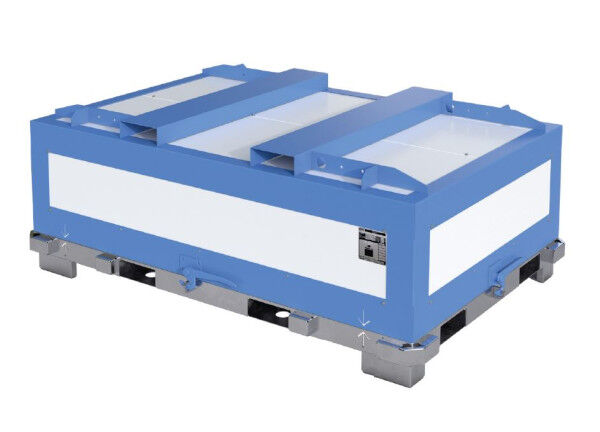incl. VAT.
Please note: Notes on delivery time
Free shipping (Germany, mainland)!
Shippingtime: ca. 8 Wo.
- Article no: TPBLIPF830

Questions about the article?
Our staff member Petra Fürbeck is happy to help you:
+49 (0) 7151 - 256 4817 or info@lion-care.com
| Handling the filling material: | without filling material |
| Empty weight: | 545 kg |
| max. gross mass: | 1195 kg |
| Material name: | Sheet steel (hot-dip galvanized) |
| Volume: | 770 l |
| Packaging group: | Packaging group I |
| Packaging instructions according to ADR: | LP 903, LP 906 |
| ADR special provision: | SP 376 |
| UN packaging code: | UN 50A/X/****/GB/BAUER-7465/2242/1195 |
| Areas of application: | Automotive, Outdoor storage, Safe transportation of critically defective lithium-ion batteries, fire-protected storage, stationary containment, Transport of rechargeable batteries, critically defective batteries, Storage, Transportation |
| External dimensions: | 2180 x 1480 x 845 mm |
| Filling material: | Fire protection panels |
| Internal dimensions: | 1840 x 1160 x 355 mm |
The transport container was developed for the safe transportation of critically defective lithium-ion batteries. In contrast to comparable metal boxes in packaging group I, no filling material is required here. This makes this container the ideal solution for in-house storage and transportation for all battery conditions. The container has been tested and meets the requirements of ADR/Packing Instruction LP 906 for max. 42.2 kWh BEV batteries. Please contact us if you have any questions.
Size and capacity of the battery transport container
The transport container has external dimensions of approx. 2180 x 1480 x 845 mm (LxWxH). Inside the box, the dimensions are 1840 x 1160 x 355 mm (LxWxH). The tare weight of the transport container is approx. 545 kg. The maximum permissible total weight is 1195 kg. It is also approved for use as large steel packaging. The stable base frame can be retracted on 4 sides for forklift trucks, the underride height is 100 mm. The container can be stacked up to a maximum load of 1950 kg. The packaging has been tested and meets the requirements of ADR/packaging instruction LP 906 for max. 42.2 kWh BEV batteries. Included is a drip tray incl. fire protection plate for collecting electrolyte. The hood is made of sheet steel with fire protection panels, it has 2 entry pockets and 4 crane eyes for lifting the hood. The transport container is also equipped with a positioning aid and collision protection.
Fire protection panels and fire protection plate
The fire protection panels are 100 mm thick and have a fire resistance class of EI 90 in accordance with EN 13501-2.
The fire protection panel consists of a non-combustible panel material with a thickness of 42 mm.
Use of the LIP-F 830 transport and storage container
the integrity of the container and all components must be checked before each use. Only trained and instructed personnel may be entrusted with the installation, storage, relocation and transportation. Depending on the battery (design, energy content, condition, etc.), the distances between the battery and the container walls may need to be adjusted. A forklift must be used to lift the cover from the base plate. Access lugs for lifting are located on the lid of the container. The lithium-ion batteries are secured to the base plate using the straps provided.
Storage instructions
The storage of hazardous goods in defective and leaking transport containers is prohibited. The storage area must be set up on a level surface, well ventilated and under a roof. Care must be taken to ensure that the transport container is protected from the weather, direct sunlight and radiant heat.
Transport instructions
All legal regulations and any markings and labels must be observed during transportation. All handling and transportation of the container must be carried out using suitable and safe means. Before transportation, make sure that the cover is firmly attached to the base frame.
Repair and disposal
Damaged transport containers must not be reused. Repairs may only be carried out by specialists authorized by the manufacturer or by the manufacturer himself. Contaminated components must be disposed of properly in accordance with their contamination.
Individual color design possible
In this version, the container is finished in the color RAL 5012 light blue. Other colors are available on request. Please contact us if required.
Certification and guidelines
Lithium batteries fall into dangerous goods class 9, which means that numerous specifications and guidelines must be observed when transporting lithium batteries. The transport box has been specially designed for the strictest safety regulations.
Certified for packaging group I
The LIP-F 830 container meets the requirements of packaging group I, which means that substances with a high hazard potential may be transported in it. To achieve this classification, many test requirements must be met. These include, for example, various drop tests from a height of 1.8 m. All packaging with the code "X" may be used for packaging groups I (II and III).
Meets the guidelines of ADR / packaging instruction LP 906
All lithium-ion cells or batteries and lithium-metal cells or batteries that have been damaged and no longer comply with the applicable regulations according to their manual must comply with the provisions of this special provision. This applies, for example, to cells that have leaked or degassed, have suffered external or mechanical damage or have been identified as defective for safety reasons or could no longer be diagnosed prior to transportation. If it is determined that the lithium-ion cells or batteries could be prone to rapid decomposition, dangerous reaction, flame generation, dangerous heat generation or dangerous emission of toxic, corrosive or flammable gases or vapors under normal transport conditions, these defective cells must then be transported in accordance with packing instruction P 911 or LP 906. These packaging guidelines in turn prescribe packaging group I.
During a possible damage to the lithium-ion battery, the surface of the package must never exceed 100°C. Only short-term temperature peaks of up to 100°C are permitted. Only short-term temperature peaks of up to 200°C are permitted. No flames may form outside the package and no splinters may escape from the package. Furthermore, the structure of the package must be maintained at all times and a gas management system must ensure pressure relief inside.
If you would like to use the container for the transport case "critically defective" in accordance with LP 906, please contact us to obtain the corresponding procedure specification for this transport case: info@lion-care.com or +49 7151 256 4811 .
Also ideal for transporting as-new lithium-ion batteries in accordance with LP 903 and as a storage and quarantine box
As no filler is required, the container is also ideal as a quarantine container for defective batteries in order to isolate a possible fire from the outset. Thanks to the hazardous goods approval, the critically defective battery can be transported away directly. In addition to critically defective batteries, the transport container is also suitable for the regular shipment of new goods in accordance with packaging regulation LP 903.
Future-oriented
Lithium-ion batteries will be indispensable in all industrial applications in the coming years. However, if used improperly, batteries can pose a potential hazard during production, storage and transportation that should not be underestimated. By purchasing these boxes, you protect yourself against major financial losses right from the start.
In use for you
If you have any questions, please do not hesitate to contact us. We look forward to hearing from you!
| Suitable for critically defective?: | Yes |
| Coding: | 50A |
| Filling material supplied: | without filling material |
| Volume: | 84 - 600 l, > 600 l |
| Handling the filling material: | without filling material |
| Type of packaging: | Large hazardous goods packaging (LP) |
| Material: | Steel |
| Type: | Storage box |
| Empty weight: | 545 kg |
| max. gross mass: | 1195 kg |
| Material name: | Sheet steel (hot-dip galvanized) |
| Volume: | 770 l |
| Packaging group: | Packaging group I |
| Packaging instructions according to ADR: | LP 903, LP 906 |
| ADR special provision: | SP 376 |
| UN packaging code: | UN 50A/X/****/GB/BAUER-7465/2242/1195 |
| Areas of application: | Automotive, Outdoor storage, Safe transportation of critically defective lithium-ion batteries, fire-protected storage, stationary containment, Transport of rechargeable batteries, critically defective batteries, Storage, Transportation |
| External dimensions: | 2180 x 1480 x 845 mm |
| Filling material: | Fire protection panels |
| Internal dimensions: | 1840 x 1160 x 355 mm |
That depends on various factors that need to be considered:
- size of the battery(ies)
- condition (e.g. non-critical, defective, critically defective or prototype)
- power
Transport boxes are available in many different sizes and specifications. The packaging group for which the box is suitable is indicated for each product.
Find out more in our blog article:
https://www.lion-care.com/aktuelles/blog/transportvorschriften-regeln-und-sicherheitsmassnahmen
Even if the batteries are not critical, remember to protect them from shocks and to order appropriate filling material if it is not already included in the box.
Yes. Should a battery reach a critical state and cause a fire, separating the batteries will prevent the fire from spreading and multiplying.
Generally, the insulation and protection material should line all sides of the container. The batteries are stored between individual layers.
We also have containers in our program that already have the protective material integrated into the outer wall. No further protective layer is necessary here.
The technical principles for storage and transportation solutions are very similar. The transport boxes are also subjected to extensive tests in accordance with ADR (drop test, fire test, etc.) to confirm compliance with the ADR regulations. The packaging regulations are extensive and regulated by law.
There are currently no comparable regulations for storage. Nevertheless, manufacturers of storage boxes regularly carry out appropriate tests.
The right container depends on the type and size of the battery to be shipped or stored.
If you want to learn more about battery storage and transportation, you will find the answers in our blog articles:
https://www.lion-care.com/aktuelles/blog/transportvorschriften-regeln-und-sicherheitsmassnahmen
https://www.lion-care.com/aktuelles/blog/lithium-ionen-akkus-sicherer-umgang-und-richtige-lagerung
The transportation of batteries is subject to ADR regulations.
The number, size and weight, energy density and condition of the batteries are crucial parameters for finding a suitable transport container for lithium-ion batteries. The selection process is complex and should be carried out by appropriately trained personnel. We have a trained hazardous materials officer on our team. Please feel free to contact us.
Plastic containers are cheaper but not as durable as metal containers. They are suitable, for example, for non-critical batteries, defective batteries, prototypes and end-of-life batteries. They can be used for both storage and transportation.
Metal containers are required, for example, when dealing with critically defective batteries.
The exact packaging instructions for these cases can be found in the ADR or by consulting a certified hazardous materials specialist.
To date, there are no legal requirements for the storage of lithium-ion batteries, which does not mean that they should be stored without suitable protective measures.
It is best to check with your insurer to find out which measures they recognize as suitable in the event of a claim.
For example, a suitable box could already be recognized as spatial separation.
A rough overview can be found in this VDS publication from the GDV:
https://shop. vds.de/download/vds-3103/ccb1d439-ad9d-47cb-a2b1-ace23e155610
Please also read our blog article on this topic:
https://www.lion-care.com/aktuelles/blog/lithium-ionen-akkus-sicherer-umgang-und-richtige-lagerung







